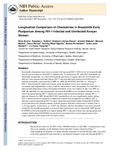| dc.description.abstract | Breastmilk chemokines have been associated with increased HIV-1 RNA levels in breastmilk and altered risk of mother-to-child HIV-1 transmission. To characterize CC and CXC chemokines in breastmilk postpartum, we collected breastmilk specimens at regular intervals for 6 months after delivery from women with and without HIV-1 infection and used commercial ELISA kits to measure breastmilk concentrations of MIP-1alpha, MIP-1beta, RANTES, and SDF-1alpha. Among 54 HIV-1-infected and 26 uninfected women, mean chemokine levels were compared cross-sectionally and longitudinally at days 5 and 10, and months 1 and 3 postpartum. For both HIV-1-infected and uninfected women, breastmilk chemokine levels were highest at day 5 for MIP-1alpha, MIP-1beta, and SDF-1alpha, and subsequently decreased. RANTES levels remained constant over the follow-up period among HIV-1-uninfected women, and increased moderately among HIV-1-infected women. For MIP-1beta and RANTES, breastmilk levels were significantly higher among HIV-1-infected women compared to uninfected women early postpartum. In addition, HIV-1-infected women transmitting HIV-1 to their infant had consistently higher breastmilk RANTES levels than those who did not transmit, with the greatest difference observed at 1 month (2.68 vs. 2.21 log10 pg/mL, respectively; p = 0.007). In summary, all four chemokines were most elevated within the first month postpartum, a period of high transmission risk via breastmilk. MIP-1beta and RANTES levels in breastmilk were higher among HIV-1-infected women than among uninfected women, and breastmilk RANTES was positively associated with vertical transmission in this study, consistent with results from our earlier cohort | en |

